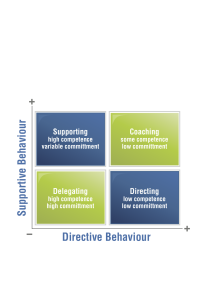 Want to know what the worst thing that can happen in a training room is? Losing people’s attention. One size does not fit all when it comes to training and managing people. You have to adjust your approach in a heartbeat.
Want to know what the worst thing that can happen in a training room is? Losing people’s attention. One size does not fit all when it comes to training and managing people. You have to adjust your approach in a heartbeat.
When you’re a trainer you have to get really good at herding the group; they’re like animals sometimes. The same can be said for managing a team. People have different levels of direction and support they need to get a job done
Making Sure You Speak Everyone’s Language
You can use this flip chart in two ways:
- Use this flip chart to help learners work out how to manage their staff more effectively.
- Use this flip chart to help guide you in assigning duties to your learners.
This flip chart is created from the school of thought around situational leadership. I’ve changed it up a little and called it situational training.
How to Use This Flip Chart
When discussing it with a training group in a leadership or management training you can use the story of a new hire to walk through the flip chart; ask:
Where a new hire might enter this grid?
What behaviours do they demonstrate?
How do they move through the grid, what do you do as a manager to help them (or not do, to hinder them)
What organisational constraints exist to thwart commitment and competence?
“Once you’ve established a good understanding of this approach to situational leadership you can use it to help your participants understand their staff.”
You can ask your learners where they would plot their current staff on the grid.
Then, with the information you gleaned from the previous questions you can help them strategise how to deal more effectively with their staff to move them from where they are on the grid to where you want them to be (ideally, delegating)
Let’s switch hats a little with the flip chart and focus attention on how it can be implicit in your mind when assessing your learners current level of competence an commitment.
How to Guide Your Learners
Let’s now look at how to guide your learners in the training.
- Coaching. The questions you ask these learners should seek to build their engagement and commitment to the training you are running.
- Supporting. These folks can probably already do what you are training, or pick it up pretty quick, you just need to give them stretch targets to achieve or ask them how they can help others. These folks probably shouldn’t be in the training, but they can be a great ally to help you with the coaching and directing participants.
- Directing. Can be a drag on your training goals. These folks need lots of attention. Use lots of what-if questions and present them with worst-case scenarios.
There’s a lot more to the kind of questions you ask learners that’s not in the scope of this post.
See my post on GROW and ORID for more ideas on how to get the right questions going.






